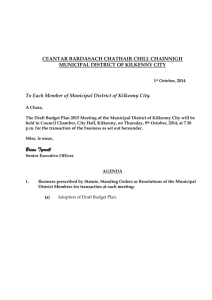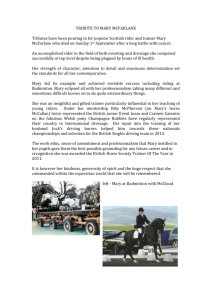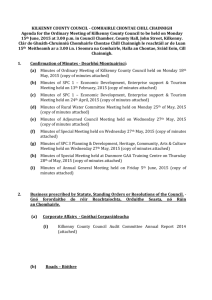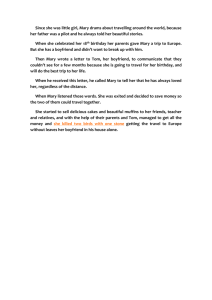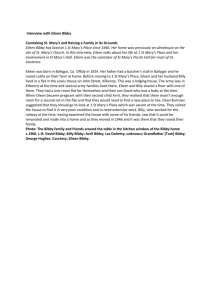Interview with David Bibby & Eileen Bibby Growing Up in St. Mary`s
advertisement
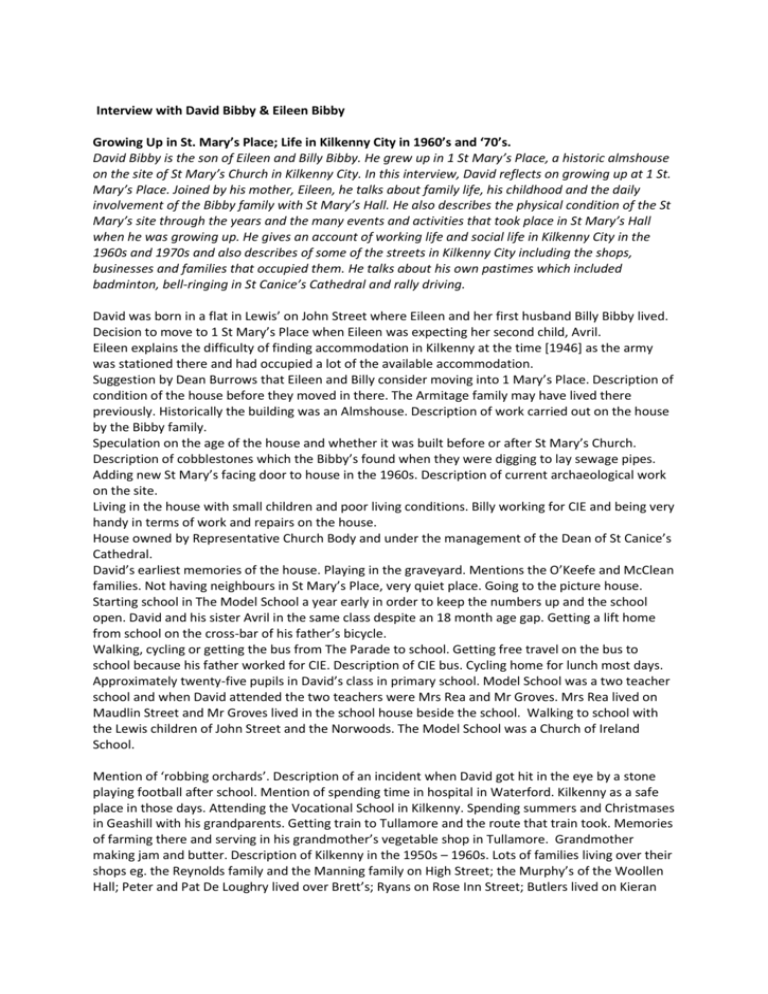
Interview with David Bibby & Eileen Bibby Growing Up in St. Mary’s Place; Life in Kilkenny City in 1960’s and ‘70’s. David Bibby is the son of Eileen and Billy Bibby. He grew up in 1 St Mary’s Place, a historic almshouse on the site of St Mary’s Church in Kilkenny City. In this interview, David reflects on growing up at 1 St. Mary’s Place. Joined by his mother, Eileen, he talks about family life, his childhood and the daily involvement of the Bibby family with St Mary’s Hall. He also describes the physical condition of the St Mary’s site through the years and the many events and activities that took place in St Mary’s Hall when he was growing up. He gives an account of working life and social life in Kilkenny City in the 1960s and 1970s and also describes of some of the streets in Kilkenny City including the shops, businesses and families that occupied them. He talks about his own pastimes which included badminton, bell-ringing in St Canice’s Cathedral and rally driving. David was born in a flat in Lewis’ on John Street where Eileen and her first husband Billy Bibby lived. Decision to move to 1 St Mary’s Place when Eileen was expecting her second child, Avril. Eileen explains the difficulty of finding accommodation in Kilkenny at the time [1946] as the army was stationed there and had occupied a lot of the available accommodation. Suggestion by Dean Burrows that Eileen and Billy consider moving into 1 Mary’s Place. Description of condition of the house before they moved in there. The Armitage family may have lived there previously. Historically the building was an Almshouse. Description of work carried out on the house by the Bibby family. Speculation on the age of the house and whether it was built before or after St Mary’s Church. Description of cobblestones which the Bibby’s found when they were digging to lay sewage pipes. Adding new St Mary’s facing door to house in the 1960s. Description of current archaeological work on the site. Living in the house with small children and poor living conditions. Billy working for CIE and being very handy in terms of work and repairs on the house. House owned by Representative Church Body and under the management of the Dean of St Canice’s Cathedral. David’s earliest memories of the house. Playing in the graveyard. Mentions the O’Keefe and McClean families. Not having neighbours in St Mary’s Place, very quiet place. Going to the picture house. Starting school in The Model School a year early in order to keep the numbers up and the school open. David and his sister Avril in the same class despite an 18 month age gap. Getting a lift home from school on the cross-bar of his father’s bicycle. Walking, cycling or getting the bus from The Parade to school. Getting free travel on the bus to school because his father worked for CIE. Description of CIE bus. Cycling home for lunch most days. Approximately twenty-five pupils in David’s class in primary school. Model School was a two teacher school and when David attended the two teachers were Mrs Rea and Mr Groves. Mrs Rea lived on Maudlin Street and Mr Groves lived in the school house beside the school. Walking to school with the Lewis children of John Street and the Norwoods. The Model School was a Church of Ireland School. Mention of ‘robbing orchards’. Description of an incident when David got hit in the eye by a stone playing football after school. Mention of spending time in hospital in Waterford. Kilkenny as a safe place in those days. Attending the Vocational School in Kilkenny. Spending summers and Christmases in Geashill with his grandparents. Getting train to Tullamore and the route that train took. Memories of farming there and serving in his grandmother’s vegetable shop in Tullamore. Grandmother making jam and butter. Description of Kilkenny in the 1950s – 1960s. Lots of families living over their shops eg. the Reynolds family and the Manning family on High Street; the Murphy’s of the Woollen Hall; Peter and Pat De Loughry lived over Brett’s; Ryans on Rose Inn Street; Butlers lived on Kieran Street and their house looked over the graveyard too. The houses on Kieran Street backed up to the wall of the graveyard. Cycling their bikes around the graveyard. Playing hurling and other ball games with friends up at the Fair Green. Playing badminton in the diocesan rooms on William Street. Eileen also involved in the badminton club there. Sometimes difficult to get the numbers to make a team. At one stage there were four Bibbys on the team. Move of Badminton club to St Mary’s Hall when it opened. Hall also used by the table tennis club and the Girl Guides. David describes the activities in the Hall as ‘a lease of life’ for his parents. Describes the time and effort his parents put into taking care of the Hall because of where they lived. David was already working at Sherwoods when the Hall opened. David talks about going to the evening (7pm) service in St Mary’s Church and also sitting his scripture exam there as a child. Talks about the absence of religious education in school, it was mainly taught at home. They would also attend Sunday School or Bible Club at St Canice’s Cathedral as children. Remembers St Mary’s Church being closed many years before its de-consecration in 1957. Working in Sherwoods as a teenager after school and on weekends leaving him little time for leisure. Talks about Sherwoods as a work place at the time, including their move from 86 High Street to their current premises, which was formally Tallis’s. Talks about the variety of goods for sale in the shop from tools to chandeliers. Popularity of radio at the time. Small appliances such as cake mixers and food mixers also popular. David was trained there to repair all small appliances including kettles, irons, toasters, fencers and electric fences. Talks about charging up batteries for radios, wet and dry batteries; assembling chandeliers; repairing Christmas lights. Everything was repaired rather than discarded at that time. David specialised in domestic appliances even though he could also work on radios and televisions. Talks about the advent of television in Ireland and the demand on television sets. Trying to get BBC aerials for customers before RTÉ started. Decision to leave Sherwoods and work for himself. Working for Siemens as a travelling serviceman, working on washing machines, tumble dryers and cookers etc. Going out to work for himself again in the 1980s while still connected with Bosch Siemens and then starting to work for Mille. His retirement a couple of years ago. David’s interest in machinery and cars. Considered working for Stathams. The importance of getting a trade at the time, even though the trades were not as respected then as they are now. Earning 10 shillings a week. Enjoying going to dances in his free time. Attending his first dance in Bagnelstown when he was fourteen. Eileen teaching the children to dance. Going to dances in Mountmellick and Athy. Going to the pictures in the Regent on William Street on Friday nights. Going to dances at the Mayfair Ballroom. Description of the Mayfair Ballroom with men on one side, women on the other. Bands that visited there including Brendan Boyer and the Royal Show Band, Mike Delahunty etc. Maurice Stephens, Richie Ryan and David Ryan were his friends at the time. Missing out on leisure time and friends because he worked all the time. Moving out of 1 St. Mary’s Place around 1972. Mention of the film crew that was based in St Mary’s for the filming of Lock up your Daughters in 1964. Account of the Beer Festival which took place in Kilkenny in 1960s. Working in Kilkenny Castle for the duration of the Festival. Memories of the events and the dances from different countries being performed in the Castle grounds. Talks about the atmosphere in Kilkenny during the Festival. It took place on the June Bank Holiday weekend for about ten years. Describes beer tents in James Park. The Festival as big event in Kilkenny at the time, shops and pubs decorating their shop fronts etc. Description of Kieran Street in the 1950s and 1960s including the slaughter yard that was in the Market Yard; shoemakers; hairdressers; Mrs Smith who kept pigs; Bertie Murray’s House; Butlers busy bicycle shop; Molloys Bakery. Getting buns at Crotty’s Bakery. Griffins knick knack shop which had previously been a storeroom for Sherwoods and is now Goods Department Store. There was a bookies beside that, memories of putting a bet on there for the Grand National. There was Parson’s on Rose Inn Street which is now Syd Harkins pub. Story about his father, Billy coming upon a robbery in Woolworths. Mention of Garda Tom Sinnott catching the robbers. Getting used to his father’s [Billy] work routine – starting work at 3am and finishing at 1pm or 6pm. Being quite in the house so that his father could sleep during the day. Billy would go to Carlow in his petrol lorry to pick up the newspapers and then come back to Kilkenny and on to Thomastown, Waterford, Carrick-on-Suir, Clonmel, Ballypatrick and back home. Worked for CIE for sixteen years. 00:44:40 CIE as employers and the wages that Bobby received. He went on to work as an inspector travelling around beet farms in Carlow. Retired in 1980. Working life in Kilkenny in the 1950s and 1960s. Difficult to get government jobs without ‘having a few strings to pull’. Going for an interview at Smithwick’s Brewery. The boot factory was another local employer. People were also carpenters, mechanics, plumbers and electricians. There were jobs for everyone. Most of his friends from the Vocational School got work, there were very few that didn’t. Talks about when he went out working for himself and then joining Seimens and Mille to gain more experience. People no longer repairing appliances because of the cost of parts. The system of going to a company for training has gone in his area of work. Talks about his son Neil and the difficulty of getting experience after college to get into the workplace. It was easier in David’s time. Talks about his interest in hot-rodding and rallying. Participating in autocrosses in Mondello and road races in Carlow, Clonmel, Kilkenny and Waterford from the 1970s up to 1990. Building cars, winning Carrick-on-Suir club events. Rod-iron field race events in Mullinavat. Eileen enjoyed being out in the middle of it all. Socialising together as a family. Going to the Fox and Goose pub on a Saturday night for singing nights and competitions, David, Bobby and Avril were singers. Billy played the mouth organ and the piano accordion. Account of being a bell-ringer in St Canice’s Cathedral. Participating in choir in St. Canice’s. Ringing the bells to ring in the new year every New Year’s Eve. Muffling the bells. Attending services at St John’s and St Canice’s when St Mary’s Church closed. Going to service early so that they could go fishing for the afternoon. Church of Ireland population of Kilkenny in the 1950s and 1960s which has depleted since. St John’s considered ‘the farmers’ church’, all the farmers would go there but St Canice’s Cathedral was considered more formal, there would be choir. The same clergy would service both churches – the Dean and the Curate. Opening of St Mary’s Hall. Cake, buns and tea, all of the parish helping out. The Choral Festival would also use St Mary’s Hall for events if it was raining. It took place in August every year and choirs from all around the Diocese of Ossory would attend. Family involvement in helping out at events in the Hall. The condition of the grounds when the Hall was opened, clearing trees and cleaning up the grounds. Eileen and Bobby weed killing twice a year. When the Dean changed [late 1980s], he took over the management of the Hall, bookings etc. Mention of Grandfather Bibby being in the Auxiliary Hospital on Wolfetone Street which was a convalescence home in Kilkenny. Mention of the fire in the Town Hall in the late 1980s. Remembers the back part of the Town Hall being built by the Cleere’s. The use of timber scaffolding and ropes. The death of one of the workers on the site. The Hall was at its peak from the 1960s-1980s. Fundraising activity to pay for the development of St Mary’s Hall made it very busy during those years. Strong sense of community spirit. Difficult to keep the activity going after older people that would have frequented the Hall and organised events there had died. That brought an end to some of the flower shows, coffee mornings, etc. Once the Hall was paid for, the momentum died down. Money was generated from car park there which paid for the running costs of the Hall. Putting money in the metre in the Hall to pay for the lights for badminton. Eileen’s enjoyment of being involved in the Hall, it was a great interest. Looking forward to events there, whist drives etc. Badminton would take place on Mondays and Thursdays; table tennis was on Tuesdays and Wednesdays, depending on matches; whist drives, card games, dances. Dances tended not to be as well supported because they did not have a bar licence. Sometimes trouble in the Hall when people came in to dances after the pubs closed. Eileen taught a lot of young people how to dance. She would always begin dances with the ‘Paul Jones’ to get everyone on the floor. The whole dancing scene changed in general in the late 1980s as people preferred to go dancing where there was a bar. Discos also became more fashionable, the number of events in hotels increased. David talks about the current revival in social dancing. How Eileen and David felt about the Hall being sold to the Borough Council. Hoping it will be used more as a result. When activity in the Hall slowed down, Eileen was still kept busy with the car park and also with her eight grandchildren. No folklore or superstitions associated with the sight. Eileen and David more concerned about antisocial behaviour and vandalism in the graveyard. The Harpers would bring couches into the Hall in the summer time after the Hall became quiet and play games. Prayer meetings were also held there. Gates put up at the entrance of the site to keep vandals out. Cameras also put in to monitor the site. Not sure what the plans are for the site, mention of a museum. David talks about how his parents made a lovely home for the family. The door was always open, people coming and going, always a cup of tea on. There was no need to lock doors. Mention of the filming of Lock up your Daughters. Caravans parked in the grounds of St Mary’s. Sherwoods did a lot of electrical work for the film company. Mentions Christopher Plummer, Susannah York, Petula Clarke, Betty Davis and Bill Wesley with whom they became friends. Talks about his father going fishing and catching a salmon with Jim Dale. Taking the salmon to Newpark to freeze it and Jim talking it back to England to be mounted. The crew would have been in Kilkenny for about three months in total. Meeting Bill Wesley in the Top Hat Ballroom Dun Laoghaire for the filming of The Commitments. Being taken around Pinewood Studios by Bill in later years. The many memories they have of living at St Mary’s, playing hurling against the wall etc. Enjoyed following rugby, mention of Jack Knockley when he was staying in the Carmel Hotel. Followed Kilkenny rugby all over the country. Talks about dangers of rugby playing. Son Jeffrey playing soccer and hockey. Talks about his daughter Jill playing hurling growing up with the Comerford brothers in Meadow Way on the Castlecomer Road where they lived. Talks about going to Croke Park. ______________________________ This is one of a series of interviews with people associated with St. Mary’s co-ordinated by the Kilkenny Heritage Office and funded by Kilkenny Borough Council. The interviews are part of an on-going programme of conservation and development works being undertaken by the Local Authority in St. Mary’s.
